CGR 1st Class 0-4-0ST 1876
| CGR 1st Class 0-4-0ST 1876 to South African Class 01 0-4-0ST 1876 | |
|---|---|
|
Cape Government Railways 1st Class 0-4-0ST of 1876 | |
| Type and origin | |
| Power type | Steam |
| Designer | Hunslet Engine Company |
| Builder | Hunslet Engine Company |
| Serial number | 168, 185-186 |
| Build date | 1875-1876 |
| Specifications | |
| Configuration | 0-4-0ST |
| Gauge | 3 ft 6 in (1,067 mm) Cape gauge |
| Driver diameter | 30 in (762 mm) |
| Wheelbase | 6 ft (1.829 m) |
| Length | 20 ft 9 in (6.325 m) over couplers |
| Height | 10 ft (3.048 m) |
| Weight on drivers | 13 5⁄20 long tons (13.5 t) w/o |
| Locomotive weight | 13 5⁄20 long tons (13.5 t) w/o |
| Fuel type | Coal |
| Fuel capacity | 3⁄4 long ton (0.76 t) |
| Water capacity | 280 imp gal (1,300 l; 340 US gal) |
| Boiler |
2 ft 5 1⁄2 in (0.749 m) outside diameter 9 ft 6 in (2.896 m) inside length 4 ft 4 1⁄2 in (1.334 m) pitch |
| Boiler pressure | 130 psi (900 kPa) |
| Firegrate area | 4.5 sq ft (0.42 m2) |
| Heating surface: – Tubes | 270 sq ft (25 m2) |
| – Firebox | 30 sq ft (2.8 m2) |
| – Total | 300 sq ft (28 m2) |
| Cylinders | Two |
| Cylinder size |
9 1⁄2 in (241 mm) bore 16 in (406 mm) stroke |
| Valve gear | Stephenson |
| Performance figures | |
| Tractive effort | 4,693 lbf (21 kN) at 75% pressure |
| Career | |
| Operator(s) |
Cape Government Railways South African Railways [1] |
| Number in class | 3 |
| Number(s) | E2-E4 |
| Delivered | 1876-1877 |
| First run | 1876 [2] |
The CGR 1st Class 0-4-0ST of 1876 is a South African steam locomotive from the pre-Union era in the Cape Colony.
In 1876 and 1877 three Cape gauge saddle-tank locomotives with a 0-4-0 wheel arrangement were placed in service on the Eastern System of the Cape Government Railways. They were designated 1st Class when a classification system was adopted.[1][2][3]
Manufacturer
The Hunslet Engine Company delivered three 0-4-0 saddle-tank locomotives to the Eastern System of the Cape Government Railways (CGR) in 1876 and 1877. They were similar to the 1st Class 0-4-0ST of 1875 in most respects, but instead of domeless boilers that took steam from the steam space above the firebox, they had steam domes with large polished brass covers.[1][2]
The first locomotive arrived in East London in 1876 and was numbered E2. Two more were delivered in 1877, numbered E3 and E4. When a classification system for locomotives was introduced on the CGR, these locomotives were also designated 1st Class.[1][2][3]
Service
Railway construction out of East London on the Eastern System only began in earnest in 1876. Along with the domeless boilered no. E1 that had arrived in East London in October 1875, these three engines were in all probability also employed as construction locomotives from the outset.[2][4]
Works numbers and renumbering
By 1888 no. E3 was scrapped and in 1897 no. E2 was sold to the Nederlandsche-Zuid-Afrikaansche Spoorweg-Maatschappij (NZASM), where it was allocated number 999.[1]
The Union of South Africa was established on 31 May 1910, in terms of the South Africa Act. One of the clauses in the Act required that the three Colonial Government railways, the CGR, the Natal Government Railways and the Central South African Railways, also be united under one single administration to control and administer the railways, ports and harbours of the Union. While the South African Railways (SAR) came into existence in 1910, the actual classification and renumbering of all the rolling stock of the three constituent railways required careful planning and was only implemented with effect from 1 January 1912.[3][4]
No. E4, by then renumbered 602, was considered obsolete by the SAR and was therefore designated Class 01 and renumbered 0602. The works numbers, year in service, original numbers and known renumberings of the 1st Class 0-4-0ST locomotives of 1876 are shown in the table.[1][3]
Works no. |
Year |
Loco no. |
1888 no. |
SAR no. |
Notes |
|---|---|---|---|---|---|
| 168 | 1876 | E2 | NZASM 999 | ||
| 185 | 1877 | E3 | |||
| 186 | 1877 | E4 | 602 | 0602 | |
See also
- CGR 1st Class 0-4-0ST 1875
- The 0-4-0 wheel arrangement
- South African locomotive history
- List of South African locomotive classes
References
|
- ↑ 1.0 1.1 1.2 1.3 1.4 1.5 Holland, D.F. (1972). Steam Locomotives of the South African Railways, Volume 2: 1910-1955 (1st ed.). Newton Abbott, Devon: David & Charles. pp. 118–119. ISBN 978-0-7153-5427-8.
- ↑ 2.0 2.1 2.2 2.3 2.4 C.G.R. Numbering Revised, Article by Dave Littley, SA Rail May–June 1993, pp. 94-95.
- ↑ 3.0 3.1 3.2 3.3 Classification of S.A.R. Engines with Renumbering Lists, issued by the Chief Mechanical Engineer’s Office, Pretoria, January 1912, p. 17. (Reprinted in April 1987 by SATS Museum, R.3125-6/9/11-1000)
- ↑ 4.0 4.1 The South African Railways - Historical Survey. Editor George Hart, Publisher Bill Hart, Sponsored by Dorbyl Ltd., Published c. 1978, pp. 11, 25.
